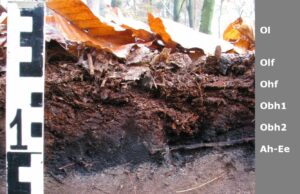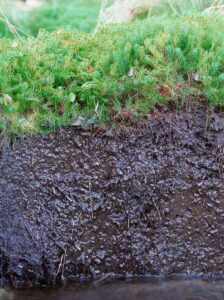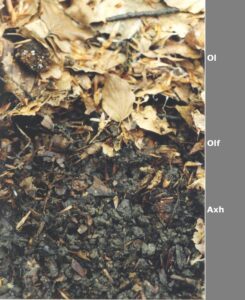Definition of Diagnostic Horizons (humus forms)
Organic master and topsoil horizon, aeromorphic to aero-hydromorphic, consisting of dead biomass (mainly plant litter).
[O from organic]
- organic carbon content ≥ 15 mass % and
- developed under aeromorphic to aero-hydromorphic conditions
Organic fine matter (OFM; fine humus) is dark-coloured, amorphous organic matter in O and H horizons and their interlocking horizons, which doesn’t have any macroscopic tissue structures.

Typical Moder with 2 different Obh-Horizons, Horizon sequence: Ol/Olf/Ohf/Obh1 (redish brown)/Obh2 (black)/Ah-Ee/Ee, forest floor material: Common beech (Fagus sylvatica) and Norway spruce (Picea abies) – © Geological Survey, North Rhine-Westphalia
Organic master horizon formed primarily by peat formation from the remains of peat-forming plants on the surface of the site under topogenous or ombrogenic excess of water. As a result of drainage and agricultural management, H horizons may be aerobically altered in a secondary pedogenic manner (Hm, Hv, Ha, Ht); after rewetting, these horizons may appear as relict horizons. Peat-forming plants are plant species that grow under special permanently wet and predominantly anaerobic site conditions.
Peat formation is the soil-forming process of accumulation of plant residues in a predominantly water-saturated environment. It is controlled by plant species, water balance, oxygen and nutrient content of the water and the duration of aeration phases. Depending on the formation conditions, different types of peat develop with varying degrees of humification as well as different humus forms and soil types.
Peat is a growing organic formation consisting predominantly of dead plant material of different degrees of humification.
- organic carbon content ≥ 15 mass % and
- formed from the remains of peat-forming plants.
Notes: The degrees of humification according to von Post are given in tha table Degree of decomposition and humification of peat . Depending on their formation, the H horizons are differentiated by additional geogenic symbols into hH, uH and nH horizons.

Mesotrophic fen, head water of river Eder, southern part of Westphalia, nHhn horizon, © Geological Survey, North Rhine-Westphalia
Dark-coloured mineral A horizon with accumulation of organic matter formed in situ, to which organic fertilisation or fresh sedimentation may also have contributed. The organic matter has usually entered the soil through roots, bioturbation, ploughing or digging activity. In acidified soils below the humus layer, dissolved organic matter may also have washed in. Features of the subsoil horizons are absent or weakly developed. The horizon may also have developed from a U or H horizon. Reasons for this can be:
- The decomposition of organic matter predominates over the accumulation of new organic matter or
- Mixing (ploughing activity and peatland melioration) with mineral substrates decreases the organic matter content.
- A horizon with visible content of organic matter and
- organic carbon content < 15 mass % and
- with accumulation of in-situ organic matter, which may also originate from organic fertilization or fresh sedimentation.
In addition to those explicitly defined horizons, deviation modified horizons can be formed with the following additional symbols:
c (secondary carbonate)
d (root felt)
k cultitropic (modified by cultivation)
z (secondary salt accumulation).
L Mull-like F-Mull, Ax-horizon, granular structure and subangular structure, Rendsic Leptosol and Calcaric Cambisol, Parent material Middle Triassic
(Photo: Christine Wachendorf)L Mull-like F-Mull, leaf material: European beech (Fagus sylvatica) on calcareous parent material (Photo: Christine Wachendorf)
Mineral master horizon, depleted by translocation of clay minerals, iron (hydr)oxides or humus.

